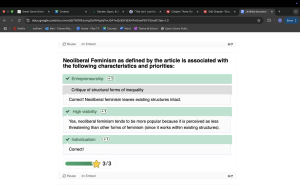3
Section One: The Fundamentals
A) Keywords
Exercise 1:
Briefly (in 100 words or less) define one of the keywords in the padlet (including one that you. may have added yourself).
| Athlete Activism
Athlete activism refers to athletes using their position as an icon or as a professional to advocate for social and political causes. It also refers to the athlete’s entire involvement in these issues, as well as their use of positional power and influence to effect positive change.
|
B) Representing Race
Exercise 2: Notebook Prompt
In about 50-70 words, consider Joel Bervell’s question: why do we feel the need to extrapolate the athleticism of one Black athlete to all Black people when we do not do the same for white athletes?
Try to think of examples when this happens, making sure to reflect on your own positionality.
|
Society is fully engaged in structural racism, constantly reinforcing stereotypes of black athletes. Media constantly suggests narratives that black athletes are more naturally more athletic. One example would be in basketball and the NBA, players like Lebron James or Anthony Edwards are always praised for their “natural talent” or “athleticism” while white players like Luka Doncic are praised for “high IQ” or “skill”. Black athletes are overlooked for the hard work and dedication that are put in to achieving such athletic heights, while white athletes are always credited for the same things. I understand the biases in sport and will continue to think and challenge norms.
|
C) Gender, Race & Sport
Exercise 3: Notebook Prompt
What are some strategies for resistance that Rajack and Joseph identify in their article as a means of pushing back against and resisting misogynoir?
|
Some strategies that are employed for resistance that Rajack and Joseph identify in their article include self-representation, social media engagement, and advocacy through fashion. As shared in the article, Naomi Osaka is a professional tennis player holding great influence and following, so choosing to use her platform for athlete activism helps push back against and resisting misogynoir. Beginning with self-representation, Osaka actively tries to control her own narrative by engaging with media. During interviews Osaka has spoken up to highlight her heritage and that her identity is correctly portrayed. Social media engagement is Osaka’s way of using athlete activism. Using online platforms like Instagram, to share authenticity of herself and her heritage. Thus, counteracting the misrepresentation caused by media. Lastly, Osaka uses fashion to highlight her Haitian and Japanese backgrounds. Collaborating with fashion icons like Pharrell Williams, to break structural norms, and express her multicultural identity.
|
Section Two: Making Connections
A) Athlete Activism
Exercise 3: Padlet Prompt
Do athletes have a responsibility to use their platform for social change? Why or why not? Please remember to record your response in both the padlet below and in your Notebook.
Yes, I personally believe that athletes do have a responsibility to use their platform for social change. Professional athletes are people who control such power and influence in today’s world, and in such case forces them to be more than just athletes. Professional athletes are role models. I also feel that professional athletes are one of the highest groups that are subject to receive discrimination and hate online. This should encourage all athletes to respond, whether they were the one receiving discrimination, it was one of their teammates, or even opponents, athletes should stand up. Professional athletes need to understand their position and affect that they have or could have on promoting social change. I feel professional athletes have the power, influence, and tools to not only promote social change, but drive the change.
B) Athlete Activism & Feminism
Exercise 4: Complete the activities




Exercise 5: Notebook Prompt
What do the authors of the article call for as a way of challenging how mainstream sports journalism privileges neoliberal feminist concerns? (100 words max.)
|
The authors Cooky and Antunovic urge sports media to “tell stories differently”. This entails questioning the privilege of neoliberal feminist concerns in sports media. The current media concentrates on individual accomplishment rather than highlighting women’s action. They believe that sports media should focus on teamwork, larger societal issues, and collective action. |
C) Corporate social justice
Exercise 6: Padlet Poll
|
I do believe that sports leagues like the NBA or NFL have a huge responsibility to support social justice movements like BLM. To reiterate the influence that athletes have on others, sports leagues hold the same influence or power that athletes do. Professional sports leagues influence culture, and hold such responsibility to support social movements and change. As stated in the article, 70% and 75% of players in the NFL and NBA are black athletes. I feel the league should be a representation of theathletes, coaches, and fans. In this case of BLM, both the NFL and NBA contain a majority of players who are in the demographic that is directly affected by the social movement, which should create a harsh urgency and responsibility for the sports leagues to help support the social movement. The NBA has done a fantastic job of supporting players and allowing them to express themselves not only as athletes but as activists, whereas the NFL has not done anything. NBA players are allowed to make social stands in unique was including celebrations, clothing, and pregame rituals. This is compared to the NFL who has banned countless things, and issue fines for players who “stand out”. I feel all leagues should support social justice movements even when it doesn’t always align with financial outcomes. |
Section Three: Taking a shot
Module Assignment (submit as part of notebook and separately through Blackboard mini assignment #1 portal)
I decided to evaluate King Richard, a 2021 film, for this assignment. Richard Williams, a sports activist, father, and coach to his two daughters, has aspired to develop Serena and Venus Williams to become professional tennis players since they were born. With the daughters being both black and racialized athletes, the film emphasizes how race and gender impact their athletic careers, highlighting the difficulties black athletes experience when entering professional sports. Venus used her confidence as a method for speaking out. In the film, she demonstrated confidence in herself, her skills, and her abilities, which led her to feel she would win, as said to an interviewer; nonetheless, her confidence was called into doubt. Her confidence challenges stereotypes about black athletes, particularly women, who are frequently perceived to be quiet and humble in athletics. Her father, on the other hand, was loud in pushing for his daughters and defended them when society questioned them. The reading “This Isn’t Just About Us” by Cooky and Antunovic (2020) discusses how media narratives impact how women athletes’ activism is seen, which is relevant to the film and how the media interprets Venus’ kind of activism. Venus’ approach tackles gender stereotypes associated with activism rather than reinforcing them.
The sisters provide plenty of comments throughout the film utilizing their voices. They are frequently questioned by the media about their boldness in sports. They do, however, show that activism can demonstrate itself in a variety of ways other than simply being loud. The sisters use their confidence and excellence to communicate with the rest of the world. Cooky and Antunovic (2020) explore how the media frequently ignores the activism of female athletes, particularly those of colour, and instead focuses on the activism of male athletes. This links to the film since Serena and Venus’ activism is frequently questioned and overlooked by the media. Much of this issue stems from their boldness, which challenges society’s stereotypes.
Overall, this film and its portrayal of the athletes influence how we interpret sports in a variety of ways. Sport is about much more than skill, athleticism, and ability. Racialized athletes confront numerous problems and barriers in sports, and these issues persist. The film emphasizes that tennis is about more than simply an athlete’s talent; it is about overcoming discrimination and confronting institutional inequities.


Feedback/Errata